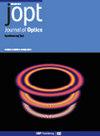水盐度对用于修改 Z 扫描方法的注入式液体透镜焦点调整的影响
IF 2.7
4区 物理与天体物理
Q3 OPTICS
引用次数: 0
摘要
我们制作了一个注水液体透镜,利用水盐度的变化来调整其焦距。研究发现,当水的盐度从零变为 34.25% 时,焦距可从 73.7 毫米变为 86.3 毫米,变化幅度约为 12.6 毫米。透镜焦点的焦距分辨率约为 0.75 × 10-2 毫米,并且在较长时间内具有较高的时间稳定性。这种透镜随后被用于修改 Z 扫描技术,在这种技术中,透镜和样品都保持固定,不会发生位移。通过对悬浮在 15 mM 浓度水中、含有 10.82-pH 合成银纳米粒子的样品进行非线性折射率测量,评估了所制造透镜的性能。为了验证结果,首先使用传统的固定焦距透镜进行经典 Z 扫描,测量出样品的非线性折射率为 (-10.6 ± 1.0) × 10-7 cm2 W-1。有趣的是,我们发现当在改进型 Z 扫描中替换制作的透镜时,可以测量到约 (-8.1 ± 0.2) × 10-7 cm2 W-1 的非线性折射率,这表明与经典 Z 扫描相比,阶次相似,系数差异较小。这一结果凸显了制作的透镜在改进经典 Z 扫描技术方面的潜在能力和简易性。本文章由计算机程序翻译,如有差异,请以英文原文为准。
Effect of water salinity on the focal tuning of an injected liquid lens used to modify the z-scan method
A water-injected liquid lens is fabricated to tune its focal length using the change in water salinity. It is found that when the salinity of water is changed from zero to 34.25%, the focal length can be changed by about 12.6 mm from 73.7 mm to 86.3 mm. A focal length resolution of approximately 0.75 × 10−2 mm and high temporal stability over a long period have been achieved for the lens foci. This lens is then used to modify the z -scan technique where the lens and the sample both remain fixed without displacement. The performance of the fabricated lens is evaluated by nonlinear refractive index measurement of a sample containing 10.82-pH-synthesized Silver nanoparticles suspended in water with 15 mM of concentration. For verification of the results, a nonlinear refractive index of (−10.6 ± 1.0) × 10−7 cm2 W−1 is firstly measured for the sample using a classical z -scan benefiting from a conventional focal-fixed lens. Interestingly, we found out that when the fabricated lens is replaced in the modified z -scan, the nonlinear refractive index of about (−8.1 ± 0.2) × 10−7 cm2 W−1 can be measured, indicating a similarity in the order and small difference in the coefficient compared to the classical z -scan. This outcome highlights the potential capability and simplicity of the fabricated lens in the modification of the classical z -scan technique.
求助全文
通过发布文献求助,成功后即可免费获取论文全文。
去求助
来源期刊

Journal of Optics
OPTICS-
CiteScore
4.50
自引率
4.80%
发文量
237
审稿时长
1.9 months
期刊介绍:
Journal of Optics publishes new experimental and theoretical research across all areas of pure and applied optics, both modern and classical. Research areas are categorised as:
Nanophotonics and plasmonics
Metamaterials and structured photonic materials
Quantum photonics
Biophotonics
Light-matter interactions
Nonlinear and ultrafast optics
Propagation, diffraction and scattering
Optical communication
Integrated optics
Photovoltaics and energy harvesting
We discourage incremental advances, purely numerical simulations without any validation, or research without a strong optics advance, e.g. computer algorithms applied to optical and imaging processes, equipment designs or material fabrication.
 求助内容:
求助内容: 应助结果提醒方式:
应助结果提醒方式:


